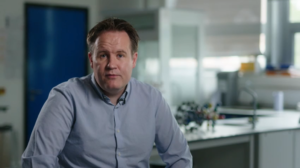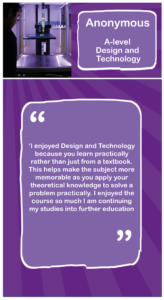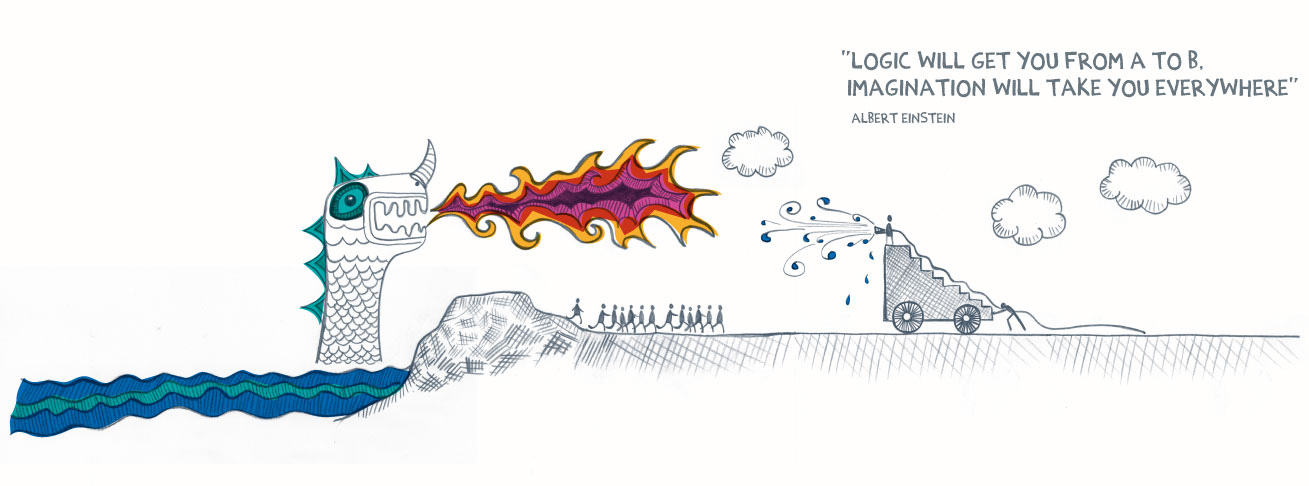Our Subject
CLICK THE IMAGE BELOW TO WATCH THE VIDEO

A Level Design and Technology: Product Design FAQs

A Level Design and Technology: Product Design is a subject that provides the opportunity to study, propose and bring to life prototype solutions closely linked to the real world of product manufacture in a range of material areas. Set your imagination free – this course will encourage you to initiate design solutions and to develop, test and trial working models and prototypes. Using your imagination, innovation and flair, you will work with concepts and materials, developing an understanding of contemporary design and technological practices and consider the uses and effects of new technologies and modern materials.
To study Design and Technology: Product Design at Bilborough, you need a grade 6 or higher in GCSE Design & Technology, or a qualification to the same grading standard in an engineering based subject. GCSE Maths at grade 5, as applied KS4 maths is a key component of the A Level Design and Technology: Product Design course. To succeed, you will need a genuine interest in design and practical applications and be confident in sketching and manufacturing.
We offer 16 maximum places to study Design and Technology: Product Design at Bilborough College. Should applications exceed the maximum, we ask students to showcase their work in the form of a GCSE Portfolio, or other relevant work they have completed. We rank all submissions and offer places based on this rank order. We will offer alternative courses, such as Art, or Electronics to students who are unsuccessful. It is not first come first serve, and more information will be emailed in due course.
Click the link to view the Design and Technology: Product Design Leaflet for all course information.
To see what sort of activities we get up to take a look through our twitter feed @fernwooddt
FAQ’s:
What are class sizes like?
Class sizes are limited to 16.
What software do you use?
For lessons we will make available to you, and upskill you in the latest commercial software (the latest Adobe suite of Photoshop, Illustrator etc., Solidworks for 2D & 3D CAD and 3D printing). We will provide you with remote access or install at home versions of software needed.
Maths and Science?
The course requires the application of GCSE level mathematics and science (no higher) both within NEA and within the examinations (15% of exam content).
English?
The examination requires several longer responses (discussion questions). As with all A-levels, you are expected to have competent English skills, being able to write clearly and justify your thinking.
How much home learning will there be?
The expectation of college life is that you will spend the same time on individual study, as you do in the classroom. This will be a mixture of research tasks, drawing tasks, practice exam questions, creativity tasks, and CAD work.
How much practical work will there be?
We do our best to learn through practical means, and the manufacturing of mini projects where possible, however the academic nature of an A-level will require a substantial volume of theory work to be covered over the two years so there will be core theory sessions running alongside this.
Where will the lessons take place?
Fernwood School, Goodwood Road, Wollaton, NG8 2FT. This is a local secondary school (11-16), rated as outstanding by OFSTED and is situated nearby the Bilborough campus.
Will I have to purchase materials?
You will be expected to provide your own drawing materials and equipment, but the basic materials needed for developmental projects and modelling will be provided. We will however expect students to independently source and purchase the materials needed for their own NEA practical.

